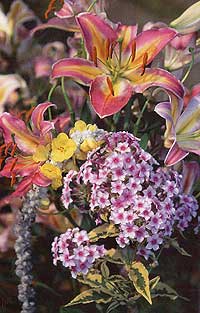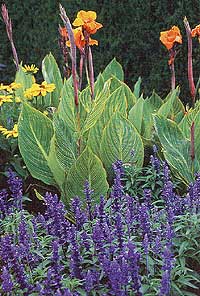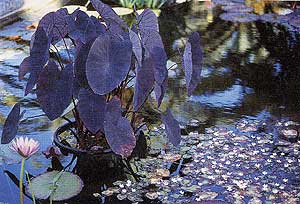Designing with Summer-Flowering Bulbs
Summer-flowering bulbs come into bloom at the same time that many perennials and annuals are at their best, and by adding them to your garden you can multiply the colors, textures, scents, shapes, and contrasts in your palette. When thinking about the best way to incorporate summer-flowering plants into the garden, it's helpful to have guidelines. Many of the following suggestions apply no matter what you're planting—perennials, annuals, shrubs, or bulbs.
Like with like: Plant sun-loving bulbs together with other plants that need a lot of sun, and do the same with shade- and wet-loving bulbs, combining them with plants that have similar light and moisture requirements. Once you've met the plants' basic needs, let your own color and design preferences guide you, and have fun discovering which plants are complementary neighbors. Wherever we combine plants with similar needs in our garden, something new and interesting is developing, blooming, or maturing all the time, and we keep going over to see what's happening. Below you'll find lots of suggestions that will inspire you to fill sunny, shady, and continually moist areas with plenty of summer-blooming bulbs.

Summer bulbs come into bloom at the same time that many perennials and annuals are at their best.
Think big: Add woody plants, colorful annuals, and a variety of perennials to your summer bulbs display to make your garden more interesting. Include shrubs and trees to give the garden "backbone," or a good, strong spine. This also adds winter interest, nesting opportunities for birds, and a nice background for the smaller flowering plants when they're in bloom.
Create a backdrop: If your garden bed is backed by trees, a wall, or a fence and won't be seen from all sides, put the taller plants towards the back, the medium plants in the middle, and the shorter ones in front, so that all of them can contribute to the salad of colors and textures. Planting colorful annuals around the edges of the garden helps to tie all the plant material together and puts "shoes and socks" on the larger perennials and bulbs.
Experiment: In the real world, plants don't fall tidily into the neat groupings we humans create for them. In our garden, we experiment all the time, looking for plants' "gray areas"—stretching hardiness zones, planting depths, and growing conditions—and we have been very pleasantly surprised to see how adaptable many plants are!
Summer Bulbs for Sun
Hymenocallis (spider lily) is one of our favorite summer bulbs; you can almost watch it come into bloom, it moves so quickly. It is adaptable, growing well in both sun and boggy areas, and is also pest-resistant. Its daffodil-like flower shape, with a distinct cup and six petals, is comfortingly familiar. And as with daffodils, its taste is repellent to deer. 'Sulphur Queen' is fragrant, especially at night, and therefore perfect for a night-garden, but works well in every setting.
Crocosmias contribute long-lasting warm colors to the garden, as the flowers stick around. Every year our Crocosmia clumps get bigger and bigger (they're perennial in Zones 6 to 10), and the flowers get better and better. With their sword-like leaves and long, lean flowers, these plants won't take up a lot of room in your beds. Black-eyed susans, other yellow daisies, and dahlias set off their colors beautifully.
Lilies are classic sun-loving bulbs. Plant them deep; they like to have their roots where it's cool. If you plant lilies deep enough, you won't have to stake them because they will develop stem roots that help prop up the plants. Incorporate lilies into the middle or back of the border. Combine Asiatic lilies with larkspurs, yarrows, Artemisia, black-eyed susans, dahlias, roses, daylilies, ornamental grasses, Stokes' asters, Alstroemeria or coneflowers. Combine oriental lilies with Cosmos, Coreopsis, Veronica, Echinops, coneflowers, Liatris, Canna, Galtonia, Mirabilis, or Lycoris.

Have fun experimenting with summer bulbs to increase the colors, textures, shapes, and scents in your garden.
The adaptable Eucomis has spectacular, plump, pineapple-shaped flower heads, which continue to look great as they form colorful seedpods, extending the bloom for a long, long time. In addition, eucomises make long-lasting cut flowers and are excellent container plants.
The many hues of Canna flowers in shades of cream, yellow, orange, red, and pink will contribute nicely to the color scheme of a garden with at least six hours of sunlight per day. Cannas also come in a range of leaf sizes, shapes, and colors, giving you even more design options. Large varieties grow to between 8 and 10 feet, medium-sized varieties hit 4 to 6 feet, and some small cannas reach a mere 2 feet, meaning they're short enough to be in the front of the garden and ideal for containers.
Dahlias come in myriad colors and shapes, and the more you have in your garden the better. Plant them densely among other plants to give them good support; otherwise, they may flop over. This is also a good reason not to grow taller types along a pathway. Keep cutting the flowers through the season, because the more you cut, the better they'll grow and continue to bloom.
In a sunny spot, combine summer-flowering bulbs with larkspurs, purple basils, some of the new, smaller ornamental sunflowers, painted daisies, bachelor buttons, and sweet williams.
Summer Bulbs for Shade
Contrary to popular belief, many bulbs thrive in shade. Achimenes, a terrific groundcover that comes in blue, pink, pure white, salmon, and a mixture of all colors, blooms throughout the summer as long as you keep it moist. Bletilla, an easy shade-tolerant bulb in the orchid family, comes in magenta or white and stands about 12 inches tall. Caladium hybrids bring light and color into shady locations with their large, brightly colored leaves. White, green, pink, and red caladiums make excellent companions with hostas, ferns, coleus, impatiens, astilbes, and any other shade-loving groundcovers. Scadoxus also performs happily in partial shade, with dramatic masses of tiny bright red florets in softball-sized flowers on 8- to 10-inch stems.
To give your garden a tropical feel, try elephant ears, Alocasia or Colocasia. With their large, often darkly veined or mottled leaves—upright in Alocasia and facing out or down in Colocasia—they provide drama and structure. Sauromatum venosum is right at home in a shady jungle garden. Its large, 1- to 2-foot finger-like leaves on purple mottled 2- to 3-inch stems will look stunning behind caladiums or in front of colocasias and hedychiums.
Sun-loving plants with great foliage will produce fewer blooms in the shade, but their foliage alone can add a lot of interest. Canna 'Striata' ('Pretoria') grows best in full sun and may not bloom as well in partial shade; but who cares about those orange blossoms when you can have the terrific yellow and green striped foliage in the shade garden!
If you live in a climate with really hot midday sun in the summer, partial shade for some of the "full sun" plants might be in order, possibly expanding the list of bulbs that work in the shade.
Bulbs for Boggy Areas
As a general rule, bulbs hate wet feet and need good drainage, but there are exceptions. Canna, Crinum, Eucomis, Colocasia, Alocasia, and Zephyranthes perform nicely in both flower borders and boggy areas. And there are other bulbs, mostly from warm tropical regions, that feel at home in swampy spots.

Like other elephant ears, Colocasia 'Black Magic' is versatile, thriving with its roots in water.
Eucharis, with its spectacular fragrant white flowers and deep green leaves, Hedychium, with 6- to 12-inch flower heads reminiscent of the wings of tropical birds, and Schizostylis, with bright fall-blooming flowers and iris-like leaves, all thrive happily in soggy conditions. Canna will also do well in a bog garden.
Achimenes is happy growing in pots and in the flower border but is especially lovely and functional around the ankles of the taller plants in the bog garden and in the front row of the tropical chorus.
Elephant ears enjoy heavy, wet soil. Both Alocasia and Colocasia produce gigantic leaves. This foliage provides a strong structural backdrop for other plants in the bog garden. Elephant ears not only thrive in wet soil, but often their hardiness increases by several zones when they are planted in a wet microclimate.
Caladium is one of the best performers to add "shoes and socks" and additional color in the foreground of a tropical-inspired garden. Caladiums come in an array of colors, shapes, and sizes and can be planted in mixtures or by color, depending on your design preference.
Crinum has very large bulbs and produces sword-shaped leaves and large clusters of fragrant, trumpet-shaped white, pink, or wine-red flowers. This pest-proof plant appears to be happy no matter where it's planted. Its flowers seem to last forever and provide us with color throughout the summer. Sauromatum venosum also performs splendidly in wet soil, adding another dimension of form with its large, tropical, hand-like leaves.
The dusky lavender to rose flowers of Joe Pye weed, and the yellow and orange blossoms of touch-me-not or jewelweed (Impatiens capensis) sway in the breeze in the late summer garden. Cardinal flower (Lobelia cardinalis), with its vivid red spikes of fire, contrasts nicely with Japanese iris (Iris ensata). And finally, don't forget to include shrubs and trees like swamp magnolia (Magnolia virginiana), river birch (Betula nigra 'Heritage'), and sweetspire (Itea virginica) to give your bog garden "backbone."
Some of the bulbs and plants described here may not be winter-hardy in Zone 6 or colder areas, but because they perform virtually all summer, they are well worth the price and effort to plant. They can be dug up after the first frost nips the above-ground foliage and stored over the winter, or they can be treated as annuals.


